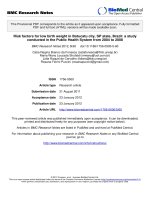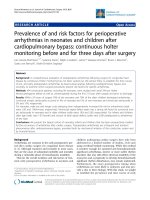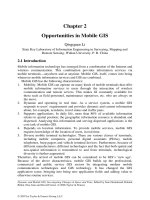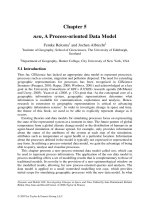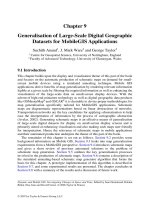Risk factors for retinal vascular changes in children and pregnant women
Bạn đang xem bản rút gọn của tài liệu. Xem và tải ngay bản đầy đủ của tài liệu tại đây (7.72 MB, 447 trang )
i
RISK FACTORS FOR RETINAL
VASCULAR CHANGES IN CHILDREN
AND PREGNANT WOMEN
LI LINGJUN, QUEENIE
(M.D., M.MED)
A THESIS SUBMITTED FOR
THE DEGREE OF PHILOSOPHY
SAW SWEE HOCK SCHOOL OF PUBLIC HEALTH
NATIONAL UNIVERSITY OF SINGAPORE
2012
ii
ACKNOWLEDGEMENTS
This dissertation would not have been possible without the guidance and help of
several individuals who in one way or another contributed and extended their
valuable assistance in the preparation and completion of this study.
First and foremost, I would like to give my utmost gratitude to my major
supervisor Prof. Saw Seang Mei, who has the attitude and quality of a genius. She
continually conveyed a spirit of enthusiasm in regards to research, scholarship, and
teaching. With her great supervision and patient guidance, I was able to finish my
investigation on two novels and well-designed studies on special populations,
including preschoolers and pregnant women. Prof. Saw’s passion in academic
research constantly inspired me to set myself with higher goals to achieve instead of
getting contented with my current performance. Even though working with her is a
challenge, it is also a great opportunity to train myself to be a better all rounded
person, since her knowledge in epidemiology, biostatics and medicine is very
comprehensive.
I hereby also place on record, my sincere gratitude to my co-supervisor Prof.
Wong Tien Yin, director of Singapore National Eye Center (SERI), Singapore
National Eye Center (SNEC) and Department of Ophthalmology, Nationa University
Hostpial (NUH), for his encouragement and unfailing support. Epidemiological
ophthalmology is a rather new field to me due to my clinical background in infectious
diseases and laboratory science in pathogenic research. During my course of research,
I have encountered all kinds of obstacles. Whenever I turn to him with my
iii
frustrations from study and work, he always showed his trust in me and took time out
from his busy schedule to provide practical resolutions for me.
I also want to thank my other co-supervisor—A/Prof. Chong Yap Seng, Director
of Department Obstetrics & Gynecology, NUS, for his moral support and steadfast
encouragement in my GUSTO retinal study. As a main principle investigator of
Growing Up in Singapore Towards Healthy Outcomes (GUSTO), A/Prof. Chong is
always easy-going and was always willing to bring himself down to our level to talk
to us students regarding our difficulties in studies and work. And he would always,
from his own pocket, award our students for obtaining good achievements. Thanks to
him, I now have my first collection of champagnes.
Over the past three years, the support and encouragements received from these
three supervisors have benefited me greatly. Prof. Saw, Prof. Wong and A/Prof.
Chong have been not only colleagues, but also friends, whose mentoring has made
my PhD a thoughtful, fruitful and joyful journey.
Furthermore, I owe sincerity and earnest thanks to my Thesis Advisory Committee
(TAC) and PhD Qualifying Examination members, who are Prof. Aung Tin and Dr.
Louis Tong. Their inputs of sharing professional insights and meticulous assessment
in my PhD study have greatly improved my academic understanding.
I am indebted to many of my colleagues Dr. Carol Cheung and Dr. M. Kamran
Ikram, who have been helping me in statistical analysis, interpretation and paper
writing. This dissertation would not have been possible without the contributions of
STARS team, GUSTO team, SERI grading team and DeVOS student team. Many
iv
thanks to their hard work, training, fun sharing and friendship offering, which has
nourished me and gave me strength to overcome any hurdles and obstacles met.
Last but not least, I am truly indebted and thankful to my parents and my Fiancé.
In order to better focus on my study and complete my curriculum, I haven’t been
taking good care of my parents, who are currently residing in Guangzhou a city in
China far away from Singapore. I want to thank them for always being so considerate,
cheerful and loving. Also, thanks to my Fiancé, Melvin, for always supporting and
believing in me. I am really lucky to have such a wonderful family, who are always
there for me, like a strong, unmovable harbor in the midst of a wild and raging sea.
v
Declaration
I hereby declare that the thesis is my orginal work and it
has been writeen by me in its entirety. I have duly
acknowledged all the sources of information which have
been used in the thesis.
This thesis has also not been submitted for any degree in
university previously.
Li Lingjun, Queenie
2 May, 2013
vi
TABLE OF CONTENTS
FRONT PAGE………………………………… ……………………………………i
ACKNOWLEDGEMENTS……………………………………….……………… ii
DECLARATION……… …………… …………………….……………………v
TABLE OF CONTENTS………… …………… …………………….………….vi
SUMMARY…………………………………………….………….……………….xvi
LIST OF TABLES……………………………………………….…………….….xx
LIST OF FIGURES…………………………………………….……………… xxvi
LIST OF APPENDICES…………………………………………………………xxix
CHAPTER ONE…………………………………………………………………… 1
1. Literature Review…………………………………………………………….….1
1.1 Introduction………………………………………….…………………….1
1.2 Measurements of Retinal Vascular Parameters……………… 2
1.2.1 Retinal Vascular caliber……………………………………………….2
1.2.2 Novel Retinal Vascular Parameters……………………………… 4
1.3 Risk factors for Retinal Vascular Caliber Changes in General
Population……………………………………………………………………6
1.3.1 Systemic Factors with Retinal Microvasculature……………………….8
1.3.1.1 Associations with Demographic Status (Age, Gender and
Ethnicity)…………………………………………….…………… 8
vii
1.3.1.2 Associations with Socio-Economic Status…………………………15
1.3.1.3 Association with Life Style Factors (Smoking and Drinking).…….17
1.3.1.4 Associations with Physical Activity and TV Viewing Time………20
1.3.1.5 Association with Blood Pressure and Hypertension……………….24
1.3.1.6 Association with Anthropometric Parameters and obesity……… 33
1.3.1.7 Associations with Markers of Inflammation and Dyslipidaemia…38
1.3.1.8 Association with Ocular Anatomic Structure…………………… 44
1.3.2 Systemic Diseases with Retinal Mi crovasculature………51
1.3.2.1 Associations with Hyperglycemia, Diabetes and Metabolic
Syndromes…………………………………………………… 51
1.3.2.3 Associations with Psychological Disorders and Neurological
Diseases………………………………………………………… 57
1.3.2.5 Associations with Food and Drugs Intake…………………………59
1.3.2.6 Associations with Vascular Diseases…………………………… 64
1.3.3 Birth Parameters with Retinal Microvasculature………………………73
1.4 Retinal Vascular Changes and Long-Term Morbidity and Mortality of
Systemic Diseases………………………………………………………….76
1.5 Pathophysiology of Retinal Microvascular Changes…………… 92
1.5.1 Mechanisms of Retinal Arteriolar Caliber Changes………………… 92
1.5.2 Mechanisms of Retinal Venular Caliber Changes…………………….93
1.5.3 Mechanisms of Retinal Vascular Tortuosity, Branching Angle and
Fractal Dimension Changes………….……………………….…… 94
viii
1.6 The Gap in Current Retinal Epidemiological Study………………95
1.6.1 Hypertension in Children and Pregnant Women……………………95
1.6.2 Obesity in Children and Pregnant Women…………………………….96
1.6.3 Pathology of Myopia in Children……………………………………97
1.6.4 Antenatal Negative Emotion in Pregnant Women……………………98
1.6.5 The Major Gap in Retinal Epidemiological Studies………………… 98
CHPATER TWO……………………………………………….……………….100
2. Methods………………………………………………………… …….………100
2.1 Objective………………………………………………………………… 100
2.1.1 General Objective…………………………………………………100
2.1.2 Specific Objective………………………………….……………….100
2.1.3 Hypothesis for Risk Factors………………………………….… 101
A. Scheme One—STARS and STARS Family Retinal Study…….….…….102
2.2 Study Design……………………………………….……………….…… 102
2.3 Inclusion and Exclusion Criteria……………………….……………… 103
2.4 Study Recruitment Flow………………………….……………….………104
2.5 Clinic Visit……………………………………….………………………105
2.6 Clinic Visit and Ethnics Consideration……………….………………….106
2.7 Study Approval……………………………………….………………… 106
2.8 Clinical Examinations…………………………………………………… 107
2.8.1 Blood Pressure Measurements……………………….……………107
2.8.2 Anthropometric Measurements…………………….……………….107
2.8.3 Eye Examination………………………….……………………… 108
ix
2.9 Fundus Photography Examination………………………….………… 109
2.9.1 Training Program………………………………………….……… 109
2.9.2 Training Assessment……………………………………….……….109
2.9.3 Retinal Photography Examination……………………….…… 109
2.10 Interview at the Clinic……………………………………….….113
2.10.1 Demographic and Socioeconomic Status……………………….113
2.10.2 Parental Life Style……………………………………….…………114
2.10.3 Birth Data from the Health Booklet……………………………….115
2.11 Retinal Vessel Caliber Assessment with IVAN Software………115
2.11.1 Grading Institute……………………………………….…………115
2.11.2 Computing and Image Requirements………………………………115
2.11.3 Procedures for Retinal Vessel Diameter Measurements………… 117
2.11.4 Data Saving Options……………………………………….………120
2.11.5 Confidentiality……………………………………….…………121
2.11.6 Data Management……………………………………….…………121
2.11.7 Reliability test of Retinal Vessel Assessments……………………122
2.12 Definition of Terms……………………………………….……122
2.12.1 Childhood Hypertension……………………………………….….122
2.12.2 Childhood Overweight and Obesity…………………….…………123
2.12.3 Abnormal Birth Parameters………………………………………123
2.12.4 Myopia, Emmetropia and Hyperopia………………….……………124
2.13 Statistical Analysis……………………………………….………124
B. Scheme Two—GUSTO Retinal Study…………………………………125
x
2.2 Study Recruitment…………………………….……………… 125
2.3 Eligibility……………………………………….………………………… 126
2.4 Study Population……………………………………….………………….127
2.5 Study Approval……………………………………….………………… 128
2.6 Clinic Operation Flow……………………………………….……………128
2.7 Clinical Examinations at 26 Week’s Visit……………………….………130
2.7.1 Blood Pressure……………………………………….…………….130
2.7.2 Anthropometric Measurements………….………………………… 130
2.7.2.1 Height…………………….……………………………………….130
2.7.2.2 Weight……………….……………… 131
2.7.2.3 Mid Upper Arm Circumference……………….………………….131
2.7.2.4 Skinfold Measurements……………….………………………….132
2.7.3 Eye Examinations……………….………………………………… 134
2.7.3.1 Fundus Photography……………….…………………………… 134
2.7.3.2 Auto-refraction……………….………………………………… 134
2.8 Retinal Vessel Assessment ……………………………………………….…134
2.8.1 Training Program……………………………………… 134
2.8.2 Training Assessment……………………………………….……….134
xi
2.8.3 Retinal Grading System……………………………………….….135
2.8.3.1 Operation Procedures……………………………………….….135
2.8.3.2 Special Notification during Grading…………………………….141
2.9 Interview at the Clinic……………………………………….…………143
2.9.1 First Clinic Visit (11-12 week) ………………………….……… 143
2.9.2 Second Clinic Visit (26-28 week) ……………………………………143
2.10 Delivery record……………………………………….……………144
2.11 Clinical Definitions……………………………………….……….144
2.11.1 Gestational Hypertension……………………………………….…144
2.11.2 Gestational Diabetes……………………………………….………144
2.11.3 Pre-eclampsia……………………………………….……………….145
2.11.4 High Risk for Pre-eclampsia………………….……………… 145
2.11.5 Maternal Obesity……………………………………….……………146
2.11.6 Weight Gain……………………………………….……………… 146
2.11.7 Mental Health……………………………………….……………….146
2.12 Statistical Analysis……………………………………….……….148
CHAPTER THREE…………………………………………………………… 150
xii
3. Results………………………………………………………………………….150
3.1 Basic Characteristics of the Study Population……………………150
3.2 Distributions of Potential Variables of Interest…………………………155
3.2.1 Distributions of Blood Pressure Measurements………………….155
3.2.2 Distributions of Anthropometric Measurements……………….…155
3.2.3 Distributions of Refraction and Ocular Biometric Parameters… …159
3.2.4 Distributions of Mental Health Assessment……………………… 161
3.2.5 Distributions of Birth Parameters……………………………… 162
3.2.6 Distributions of Serum Glucose Level…………………………….163
3.2.7 Distributions of Retinal Vessel Assessments……………………….164
3.3 Prevalence of All Variables Classified by Clinical Cut-off…………….167
3.3.1 Prevalence of Hypertension………………………………………169
3.3.2 Prevalence of Overweight and/or Obesity…………………………171
3.3.3 Prevalence of Refractive Error among Children……………………171
3.3.4 Prevalence of Antenatal Depression among Pregnant Women…….172
3.3.5 Prevalence of Antenatal Poor Sleep Quality among Pregnant
Women……………………………………………………………173
3.3.6 Prevalence of Weight Gain Classification among Pregnant
Women……………………………………………………………174
3.4 Risk Factors for Retinal Vascular Parameters Changes…………….174
3.4.1 Univariate Analysis…………………………………………………175
3.4.2 Multivariate Analysis in Cross-sectional Results……………… 189
3.4.2.1 Multiple Linear Regression…………………………………… 189
xiii
3.4.2.1.1 Blood Pressure as a Risk Factor for Changes in Retinal
Vascular Parameters ………………………………….189
3.4.2.1.2 Anthropometric Parameters as Risk Factors for Changes in
Retinal Vascular Parameters……………………………197
3.4.2.1.3 Ocular Biometric Parameters as Risk Factors for Changes
in Retinal Vascular Parameters…………………………209
3.4.2.1.4 Antenatal Mental Health Status as a Risk Factor for
Changes in Retinal Vascular Parameters ………………212
3.4.2.1.5 Birth Parameters as Risk Factors for Changes in Retinal
Vascular Parameters ………………………………… 217
3.4.2.1.6 Life Style as a Risk Factor for Changes in Retinal Vascular
Parameters…………………………………………… 218
3.4.2.2 Gender, Ethnicity, Household Income and Education as Risk
Factors for Changes in Retinal Vascular Parameters…… ……221
3.4.2.3 Stratification and Interaction……………………………………224
3.4.2.4 Multiple Logistic Regression………………………………….227
CHAPTER FOUR…………… ………………………………………………… 235
4. Discussion…………………… ……………………………………………….235
4.1 Summary of the Retinal Study in Singapore Children and Pregnant
Women…………………………….……………………………………….235
4.2 Association between Blood Pressure and Retinal Microvasculature….236
4.3 Association between Obesity, Body Fatness Indices and Retinal
Vasculature………………………………………………………………241
xiv
4.4 Association between Ocular Biometric Parameters and Retinal Vascular
Caliber among Children………………………………………………… 247
4.5 Association between Antenatal Mental Health and Retinal Vascular
Parameters among Pregnant Women……………………………………252
4.6 Associations between Gender and Retinal Vascular Caliber in
Children……………………………………………………………………256
4.7 Associations between Ethnicity and Retinal Vascular Parameters in
Pregnant Women …………………………………………………………256
4.8 Associations between Demographic Status and Life Style and Retinal
Vascular Parameters in Children and Pregnant Women………………257
4.9 Associations between Birth Parameters and Retinal Vascular Caliber in
Children……………………………………………………………………258
4.10 Associations between Retinal Microvasculature and Gestational
Complications in Pregnant Women……………………………………259
4.11 Strengths………………………………………………………… 260
4.12 Limitations…………………………………………………………262
4.13 Significance……………………………………………………… 264
4.14 Future direction………………………………………………….266
CHAPTER FIVE………………………………………………………………….268
5. Epidemilogical Aspect of Out Study……………………………………… 268
5.1 Bias…………………………………………………………………………268
5.2 Confouding………………………… ……………………………………269
5.3 Interation………………………… ……………………………………271
xv
5.4 Study Design………………………… ………………………………272
5.5 Type I and Type II Error and Significance………………………… …272
REFERENCES……………………………………… ………………………… 273
PUBLICATION LIST DURING PHD………………………………………… 292
AWARDS DURING PHD………………………………………………………293
PERSONAL CONTRIBUTION……… ……………….……………………….294
APPENDICES……………………………………………………………………295
xvi
SUMMARY
Background:
The retinal blood vasculature is accessible to noninvasive visualization allowing
for investigation of structural and pathologic features of the microcirculation and its
relationship to systemic vascular diseases. Retinal vascular changes, such as retinal
arteriolar narrowing and venular widening, have now been shown to be associated
with various cardiovascular risk factors (e.g., hypertension, diabetes) and clinical
cardiovascular disease (CVD) in the adult general population. However, such
associations have not been investigated in young children and pregnant women, two
specific populations with possible early predisposition of major systemic disease later
in life. This thesis aims to describe retinal vascular changes and examine the major
risk factors associated with such changes in Singapore children and pregnant women.
Methods:
Two studies were included in this thesis. First, a total of 586 healthy Singapore
Chinese children aged 4 to 16 years were recruited in the Strabismus, Amblyopia and
Refractive Error Study in Singaporean Chinese Preschoolers (STARS) from May
2006 through October 2008 and the STARS Family study from March 2008 through
March 2010. Second, 824 healthy pregnant women aged 18–46 years were recruited
as part of the Growing Up in Singapore Toward Health Outcomes (GUSTO) study. In
both cohorts, retinal photography was performed and retinal vascular caliber was
measured using a computer-based method.
xvii
Systemic factors such as BP, BMI, skinfold thickness, ocular biometric parameters
and mental health assessments were measured according to standard protocols.
Demographic information was collected at clinic interviews by trained staff. Retinal
photographs were taken with a Canon 45° digital retinal camera and were
subsequently graded by well-validated systems (IVAN, Interative Vessel Analysis;
SIVA, Singapore I Vessel Assessment). Masked reliability tests had been performed
before data on retinal vascular parameters were processed for statistical analysis.
Multivariate regression analysis was used to explore the associations between a range
of risk factors and retinal microvascular characteristics. Furthermore, the potential
predictive values of retinal microvasculature on incidence of gestational
complications were studied.
Results:
All variables of interests were approximately normally distributed both in children
and pregnant women. The mean central retinal artery equivalent (CRAE) and vein
equivalent (CRVE) were 155.34 µm and 218.80 µm in boys and 161.07 µm and
224.17 µm in girls, respectively. After adjusting for major potential confounders,
each 10 mm Hg increase in systolic BP was associated with a 2.00 µm narrowing in
retinal arterioles and a 2.51 µm widening in retinal venules. Each standard deviation
(SD) increase in triceps skinfold thickness (TSF) (4.49 mm) and BMI (3.52 kg/m
2
)
was associated with a 2.94 µm and a 3.40 µm widening in retinal venular calibre,
respectively. Each 1.0mm increase in axial length was associated with a 3.52µm
decrease and a 5.55µm decrease in retinal arteriolar caliber and retinal venular caliber,
respectively. By using specific cut-offs to classify childhood hypertension and
xviii
childhood overweight/obesity, children with BP above thresholds tended to have
narrower retinal arteriolar caliber and children with BMI/TSF above thresholds
tended to have wider retinal venular caliber, compared with those with BP, BMI or
TSF below thresholds.
The mean CRAE and CRVE were 120.09 µm and 169.94 µm in Chinese pregnant
women, 122.59 µm and 172.81 µm in Malay pregnant women and 122.44 µm and
169.21 µm in Indian pregnant women, respectively. In multivariate analysis, every 10
mmHg increase in mean arterial blood pressure (MABP) was associated with a 1.9
µm reduction in retinal arteriolar caliber, a 0.9° reduction in retinal arteriolar
branching angle, and a 0.07 reduction in retinal arteriolar fractal dimension,
respectively. Patients classified into high-risk group in developing pre-eclampsia
(MABP≥90 mmHg) was twice as likely (Odds Ratio: 2.1, 95% CI: 1.0, 4.4) to have
generalized retinal arteriolar narrowing compared with those classified into low-risk
group (MABP<90 mmHg). Compared with mothers with normal weight, obese
mothers (pre-pregnancy BMI>30.0 kg/m
2
) had narrower retinal arteriolar caliber
(118.81 vs. 123.38 µm, p<0.001), wider retinal venular caliber (175.81 vs. 173.01 µm;
p<0.01) and increased retinal venular tortuosity (129.92 vs. 121.49 x10
-6
; p<0.01).
Each SD increase in the Edinburgh Postnatal Depression Scale (EPDS) (4.49 scores)
and in the Pittsburgh Sleep Quality Index (PSQI) (2.90 scores) was associated with a
0.80µm (p=0.03) and a 1.22µm (p=0.01) widening in retinal arteriolar caliber,
respectively. However, changes in retinal vascular parameters were not associated
with incidence of gestational complications reported upon delivery.
xix
Conclusion:
In both children and pregnanet women, elevated blood pressure and greater BMI
were significantly associated with retinal arteriolar narrowing and/or retinal venular
widening. Longer axial length and greater corneal curvature were associated with
retinal arteriolar and venular narrowing in children. Negative antenatal emotions such
as depressive symptoms and poor sleep quality were associated with retinal arteriolar
widening in pregnant women.
Our study is the first study comprehensively investigating a range of systematic
risk factors and retinal vascular changes, reflecting the systemic microcirculation in
vivo, in young children and pregnant women. Our study provides evidence that
hypertension and obesity in childhood and in mid-term pregnancy were associated
with subclinical vascular changes, and thus further insights on the potential
pathophysiological pathways and mechanisms involved in the development of major
metabolic and cardiovascular diseases later in life.
xx
LIST OF TABLES
Table 1. Associations between Age and Retinal Vascular Caliber………………… 11
Table 2. Associations between Age and Retinal Vascular Tortuosity, Branching
Angle and Fractal Dimension…… ……………………………………… 12
Table 3. Associations between Ethnicity and Retinal Vascular Parameters…………14
Table 4. Associations between Socio-Economic Status and Retinal Vascular
Caliber…… ……………………………………………………………… 16
Table 5. Associations between Life Style and Retinal Vascular Caliber……………18
Table 6. Associations between Physical Activity, TV Viewing Time and Retinal
Vascular Caliber…… …………………………………………………… 22
Table 7. Associations between Blood Pressure, Hypertension and Retinal Vascular
Caliber…… ……………………………………………………………… 29
Table 8. Associations between Blood Pressure and Retinal Vascular Tortuosity,
Branching Angle and Fractal Dimension………………………………… 31
Table 9. Associations between Anthropometric Parameters, Obesity and Retinal
Vascular Caliber………………………………………………………… 35
Table 10. Associations between Anthropometric Parameters and Retinal Vascular
Tortuosity, Branching Angles and Fractal Dimension…………………37
Table 11. Associations between Markers of Inflammation, Endothelial Function and
Dyslipidaemia and Retinal Vascular Caliber……………………………40
xxi
Table 12. Associations between Markers of Inflammation, Endothelial Dysfunction
and Dyslipidaemia and Retinal Vascular Tortuosity, Branching Angle….43
Table 13. Associations between Ocular Anatomic Structures and Retinal Vascular
Caliber………………………………………………………………… 46
Table 14. Associations between Ocular Anatomic Structure and Retinal Vascular
Tortuosity, Branching Angle and Fractal Dimension……………………50
Table 15. Associations between Metabolic Symptoms and Metabolic Syndromes and
Retinal Vascular Caliber…………………………………………………54
Table 16. Associations between Metabolic Symptoms and Metabolic Syndromes and
Retinal Vascular Tortuosity, Branching Angle and Fractal Dimension…56
Table 17. Associations between Psychiatric and Psychological Conditions and Retinal
Vascular Caliber…………………………………………………………58
Table 18. Associations between Food and Drugs Intake and Retinal Vascular
Caliber………………………………………………………… ……… 61
Table 19. Associations between Vascular Risk Factors and Retinal Vascular
Caliber…………………………………………………………………67
Table 20. Associations between Vascular Risk Factors and Retinal Vascular
Tortuosity, Branching Angle and Fractal Dimension.……………….71
Table 21. Associations between Birth Parameters and Retinal Vascular
Parameters……………………………………………….………… 74
Table 22. Associations between Retinal Vascular Caliber and Incidence of
xxii
Hypertension………………………………………………………….…80
Table 23. Associations between Retinal Vascular Parameters and Incidence of
Metabolic Diseases………………………………………………………82
Table 24. Associations between Retinal Vascular Parameters and Incidence of
Vascular Diseases Morbidity and Mortality……………………………85
Table 25. Associations between Retinal Vascular Parameters and Incidence of Eye
Diseases……………………………….………………………………….91
Table 26. Basic Characteristic between Boys and Girls among Children with Retinal
Photography Participated in STARS and STARS Family Retinal
Study……………………………………………………………………151
Table 27. Basic Characteristic between Pregnant Women with Retinal Photography
and without Retinal Photography Participating the GUSTO Main and the
GUSTO IVF Study………………………………………………………153
Table 28. Risk Factors (categorical variables) for Retinal Vascular Caliber Changes in
Children………………………………………………………………… 175
Table 29. Risk Factors (continuous variables) for Retinal Vascular Caliber Changes in
Children……………………………………………………………… …176
Table 30. Risk Factors (categorical variables) for Retinal Vascular Caliber Changes in
Pregnant Women…………………………………………………………178
Table 31. Risk Factors (categorical variables) for Retinal Vascular Tortuosity
Changes in Pregnant Women…………………………………………179
xxiii
Table 32. Risk Factors (categorical variables) for Retinal Vascular Branching Angle
Changes in Pregnant Women…………………………………………….180
Table 33. Risk Factors (categorical variables) for Retinal Vascular Fractal Dimension
Changes in Pregnant Women…………………………………………….181
Table 34. Risk Factors (continuous variables) for Retinal Vascular Caliber Changes in
Pregnant Women……………………………………………………….184
Table 35. Risk Factors (continuous variables) for Retinal Vascular Tortuosity
Changes in Pregnant Women…………………………………………185
Table 36. Risk Factors (continuous variables) for Retinal Vascular Branching Angle
Changes in Pregnant Women …………………………………………186
Table 37. Risk Factors (continuous variables) for Retinal Vascular Fractal Dimension
Changes in Pregnant Women ……………………………………………187
Table 38. Association between Blood Pressure and Retinal Vascular Caliber…… 189
Table 39. Linear Regression Models of Retinal Vascular Caliber and Blood
Pressure……………………………………………………………….190
Table 40. Multivariate Analysis of Association between Blood pressure and Retinal
Vascular Caliber…………………………………………………………192
Table 41. Multivariate Analysis of Association between Blood pressure and Retinal
Vascular Tortuosity…………………………………………………… 193
Table 42. Multivariate Analysis of Association between Blood pressure and Retinal
Vascular Branching Angle………………………………………………194
xxiv
Table 43. Multivariate Analysis of Association between Blood pressure and Retinal
Vascular Fractal Dimension……………………………………………195
Table 44. Retinal Vascular Calibre by Quartiles of Weight, Height, BMI and TSF in
Different Models……………………………………………………… 197
Table 45. Multiple Linear Regression Analysis of 26 Weeks Gestational and Pre-
Pregnancy Body Mass Index (BMI) and Weight Gain with Retinal
Vascular Calibre…… ………………………………………………….200
Table 46. Multiple Linear Regression Analysis of 26 Weeks Gestational and Pre-
Pregnancy Body Mass Index (BMI) and Weight Gain with Retinal
Vascular Tortuosity……………………………………………………201
Table 47. Multiple Linear Regression Analysis of 26 Weeks Gestational and Pre-
Pregnancy Body Mass Index (BMI) and Weight Gain with Retinal
Vascular Branching Angle………………………………………………203
Table 48. Multiple Linear Regression Analysis of 26 Weeks Gestational and Pre-
Pregnancy Body Mass Index (BMI) and Weight Gain with Retinal
Vascular Fractal Dimension………………………………………….204
Table 49. Multivariate Analysis of 26 Weeks Gestational Subcutaneous Skinfold
Thickness and Retinal Vascular Caliber………………………………205
Table 50. Multivariate Analysis of 26 Weeks Gestational Subcutaneous Skinfold
Thickness and Other Retinal Vascular Parameters……………………206
Table 51. Multiple Linear Regression of Association between Corrected Retinal
xxv
Vascular Caliber and Refraction and Ocular Biometric Parameters…209
Table 52. Multiple Linear Regression of Associations between Antenatal Depression
Assessment and Retinal Vascular Caliber among Pregnant Women……212
Table 53. Multiple Linear Regression of Associations between State-Trait Anxiety
Inventory (STAI) and Retinal Vascular Caliber among Pregnant
Women…………………………………………………………………213
Table 54. Multiple Linear Regression of Associations between Pittsburg Sleep
Quality Index (PSQI) and Retinal Vascular Caliber among Pregnant
Women…………………………………………………………………214
Table 55. Multiple Linear Regression of Associations between Antenatal Mental
Health Assessments and Other Retinal Vascular Parameters among
Pregnant Women……………………………………………………… 215
Table 56. Multiple Linear Regression of Associations between Birth Parameters and
Retinal Vascular Caliber among Children…………………………….217
Table 57. Multiple Linear Regression of Associations between Parental Life Style and
Retinal Vascular Caliber among Children…………………………….218
Table 58. Multiple Linear Regression of Associations between Maternal Life Style
and Retinal Vascular Parameters………………………………………219
Table 59. Association between Gender, Ethnicity, Household Income and Education
and Retinal Vascular Caliber among Children……………………….221


